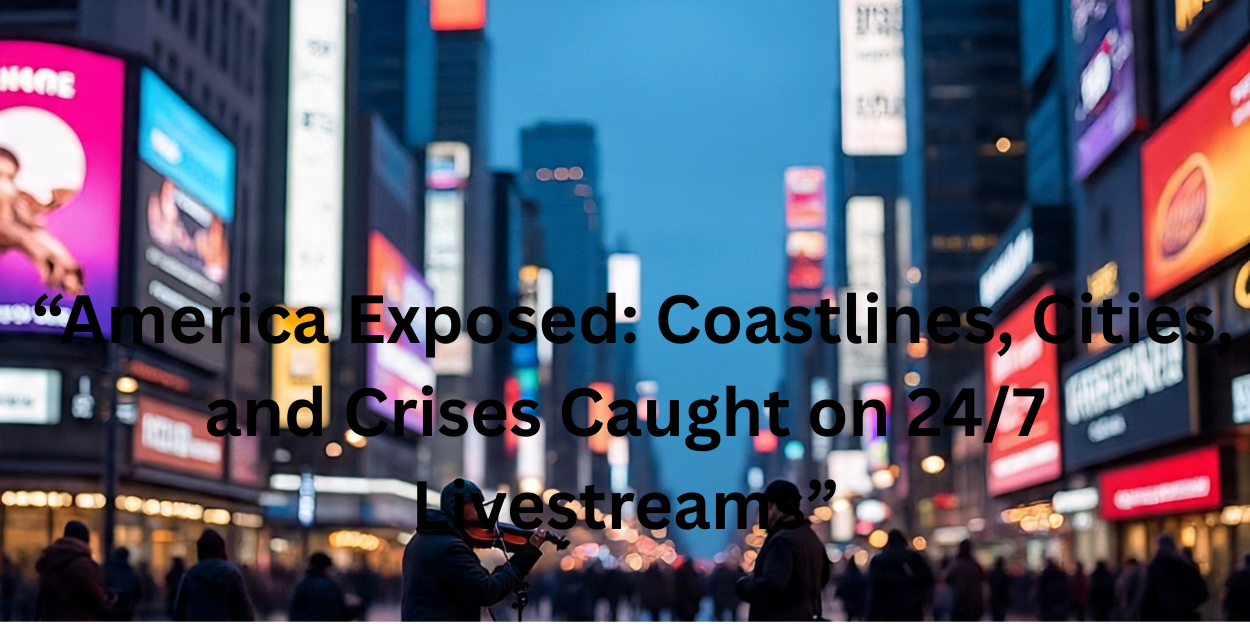FnF News
“Through the Lens: LIVE U.S. Webcams Reveal a Nation Caught Between Beauty, Chaos, and Control”
By Khadija Khan | FNF News | July 6, 2025
Across the American landscape, the pulse of daily life continues—restless, raw, and sometimes hauntingly still. The latest 24/7 broadcast of LIVE WEBCAMS around the U.S.A. doesn’t just show scenery; it captures a moment in time where weather, violence, and resilience move simultaneously in different corners of the nation.
Streaming from public squares, beachfronts, traffic corridors, border points, and iconic city skylines, the live footage serves not only as digital surveillance—but as real-time evidence of the contrasting realities Americans live in. FNF News breaks down what the cameras showed—and what they reveal about the deeper condition of the country.
1. Calm Before the Surge: East Coast Beaches Packed Ahead of Tropical Warning
From the bustling boardwalks of Myrtle Beach, South Carolina, to the crowded sandbanks of Ocean City, Maryland, webcams captured the height of summer recreation. But just beyond the horizon, meteorologists issued a tropical storm warning, as Tropical Storm Garnett formed off the Atlantic and began pushing bands of wind inland.
Lifeguards were seen pulling swimmers from choppy surf as sudden riptide conditions escalated. At Virginia Beach, automated alerts interrupted local radio and beach loudspeakers, urging tourists to evacuate low-lying zones ahead of overnight storm surges.
The National Weather Service issued a Level 3 advisory across multiple East Coast counties, warning of potential flooding, power outages, and coastal erosion over the next 48 hours.
2. Inner Cities in Tension: Cameras Watch but Can’t Intervene
In Chicago, Philadelphia, and Detroit, traffic cams and intersection views silently documented rising tension in urban cores. One downtown Detroit feed caught the aftermath of what appeared to be a late-night altercation involving armed civilians. A similar incident in South Chicago was caught in full, where police arrived minutes after gunfire rang out near a liquor store.
The visual presence of surveillance has not stopped violence. Local residents interviewed by FNF News in Philadelphia’s Kensington area expressed frustration: “The cameras are on 24/7, but no one stops anything. They just watch us suffer.”
Urban advocates argue that while city cams are meant to aid public safety, they’ve become tools of observation—not prevention. NBC and Fox local affiliates have reported similar patterns: live crime captured, then replayed—rarely stopped.
3. Weather in the West: Monsoon Sparks Mudslides and Power Failures
Webcams trained on Flagstaff, Arizona and Albuquerque, New Mexico showed nature taking a harsher turn. As part of the Southwest’s seasonal monsoon cycle, storm clouds collapsed over mountainous terrain, sending torrents of water and mud across desert roads.
Power was knocked out in parts of rural Arizona after lightning struck a substation in Yavapai County. Camera feeds from highway overpasses showed cars stranded in muddy debris, with first responders pushing stalled vehicles by hand.
Meteorologists from the National Interagency Fire Center warned of “dual threat conditions”: flooding from intense rains and the risk of wildfires igniting from lightning strikes in previously dry areas.
4. Borderline Stillness: U.S.-Mexico Crossings Show Tension Without Movement
Cameras stationed at El Paso, Nogales, and San Ysidro painted a quieter but equally fraught picture. The livestreams from border zones showed long lines of waiting vehicles, minimal pedestrian crossings, and heavy militarized presence—including CBP trucks, drones, and watch towers.
FNF analysts noted the contrast: after months of televised chaos at the border, the visual silence may suggest new restrictions, tightened controls, or simply a media blackout. However, local reports confirm that migrant holding centers are still over capacity, and asylum claim backlogs are increasing.
One live camera near Del Rio showed rows of buses parked quietly behind fencing—unmarked, but presumed to be part of the DHS migrant transport fleet.
5. Moments of Peace: Nature and Nightfall Calm the Feed
Despite chaos in various regions, not all camera feeds conveyed conflict. Viewers watched time lapse footage of sunset over the Golden Gate Bridge, fireworks exploding over Lake Michigan, and a blue heron walking the marsh edges of Everglades National Park.
In Yellowstone, a bison herd quietly moved through the foggy lowlands just after dawn. In Times Square, street preachers, tourists, and city workers moved around each other without incident, as if sharing the same stage without touching the script.
These visuals are not just filler—they serve as a reminder of the country’s layered reality. For every breaking incident or looming threat, there’s an unbroken thread of routine life still playing out.
6. America, Live and Unfiltered—But Not Always Understood
The appeal of 24/7 live webcam feeds isn’t novelty anymore—it’s necessity. In an age of media distrust and conflicting narratives, raw footage offers something that no pundit can spin: real-time evidence.
But what viewers do with that evidence is a different question. Livestreams show us the conditions, not the causes. They allow observation, but not always understanding.
FNF News continues to monitor these open lenses into America’s cities, coastlines, borderlands, and weather fronts—documenting not just what’s happening, but how fragmented the experience of “daily life” has become in the United States.

